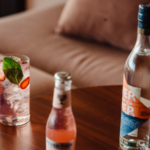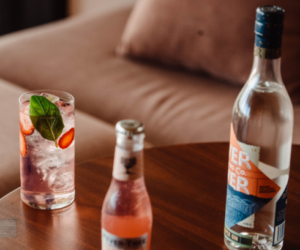 All gin goes well with tonic, however, some combinations work better than others. Some gin, especially floral styles tend to disappear when paired with classic Indian Tonic water due to the nature of the mixer. Indian tonic is quite robust and easily overpowers gin that lacks juniper intensity. Traditionally, juniper-forward gin styles will work well with most tonic water variants, especially if those tonic waters use real quinine as an ingredient. There is a special science to the way juniper flavour and quinine bond in the glass, making the g&t the most delicious form of chemistry.
All gin goes well with tonic, however, some combinations work better than others. Some gin, especially floral styles tend to disappear when paired with classic Indian Tonic water due to the nature of the mixer. Indian tonic is quite robust and easily overpowers gin that lacks juniper intensity. Traditionally, juniper-forward gin styles will work well with most tonic water variants, especially if those tonic waters use real quinine as an ingredient. There is a special science to the way juniper flavour and quinine bond in the glass, making the g&t the most delicious form of chemistry.
https://neverneverdistilling.com.au/blogs/news/the-classic-g-t-garnish-when-life-gives-you-lemons
For “fresh” ice at home should we only make it a certain timeframe beforehand? Should we invest in a specialist ice maker or is it enough to cover/put a lid on the trays? Are larger cubes best for G&Ts? How much ice should we aim for as a general rule? Any other ice tips?
Ice is the most important ingredient in the glass. You can have gin and you can have tonic, but without ice you have a warm, flat mixed drink without the fresh lift that a classic g&t delivers. A few rules on ice;
If you like g&t’s go buy a silicon ice mould tray that gives you nice fat cubes of ice. I go through ice pretty much every second day so it’s constantly being refreshed, however, if you only give it a nudge every weekend make sure you don’t stick it next to the fish fingers, or that spag bol you’ve dropped in their mid-week. It will start to taste a bit off and ruin your drink.
Buying ice cube moulds with lids will also help keep your ice super fresh.
You can also cut your own ice from a single block. It just requires practice and a little patience. Just pop a takeaway container full of water into the freezer overnight. Once it’s frozen, take it out and let it sit for 20 min in the sink to ‘cure’. Once that time is up take a sharp kitchen knife and place it at right angles to the block and give it a little tap with a rolling pin. The knife will glide through the ice and give you a nice flat edge. Repeat with each piece until you have enough ice for your drinks. If it’s chipping and making a mess the block needs to cure for longer. This is a great trick for parties where you’re making heaps of drinks that require a lot of ice.
Use PLENTY of it. The more ice, the colder the drink, the colder the drink, the less it dilutes, the less it dilutes, the less water in the glass, the less water the more bubbles! Using only a few cubes of ice is a sure-fire way of creating a flat, tepid g&t. Unless you like it that way, if that’s the case knock yourself out.
Are there any Australian tonics/tonic syrups that you recommend, in particular?
Australia is awash not only with incredible gin producers but tonic producers as well. We’re very fond of the soda and tonic waters that PS40 make. They are a little like us in the way they approach to flavour and have created some incredible products. Try their Bush Tonic with our Australian Aquavit, garnished with Thai basil for something a little different. The guys at Strange Love also create some incredible tonic waters, more aligned with traditional flavours. Their new Coastal Tonic when combined with our Med Gin is outrageously tasty. Capi is also a great Victorian tonic water  producer who does some amazing variants. We use their Native Tonic water with our Triple Juniper Gin garnished with cucumber.
producer who does some amazing variants. We use their Native Tonic water with our Triple Juniper Gin garnished with cucumber.
What proportion of G to T do you recommend that beginners start out with when mixing a new G&T combo?
Less is always more. You need to remember that tonic water still contains sugar, so even though there is a pronounced bitterness it can still feel a little tacky and sickly if you overdo it, especially with the cheap stuff (avoid tonic water from the post-mix gun, it’s a waste of good gin). I like to work with a 3-1 ratio, so three parts tonic to one part gin. So around 30ml of gin per 100m of tonic water. If it’s too strong you can always add more.
Are there any weird, wild or otherwise unusual garnishes you think are worth experimenting with (other than the usual fruit, herbs) for a G&T? Is a garnish essential to add? Should we do anything to herb or citrus garnishes to bring out their flavour/aroma?
Garnishes are a great way of adding complexity to a drink. Many add aroma, especially herbs. Citrus contributes acid which can balance out the sweetness in a drink. Likewise, fruit can also impart subtle sweetness or savoury character which can further add to the dynamics of the cocktail. I often love to pair savoury herbs with sweet fruit as it adds a unique balance to the aroma and flavour. Try combinations such as strawberry and basil, mint and cucumber, or pear and dill. They deliver some amazing results and can brighten up the drabbest gin and tonic combinations.
Join our webinar to learn more about the various usages of Gin plus the chance to win a bottle of award-winning GIN.
















